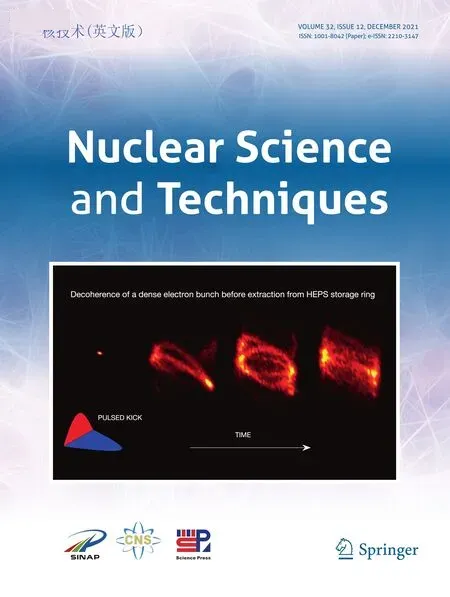Nuclear Science and Techniques
Copyright Information
For Authors
As soon as an article is accepted for publication, authors will be requested to assign copyright of the article (or to grant exclusive publication and dissemination rights) to the publisher (respective the owner if other than Springer Nature). This will ensure the widest possible protection and dissemination of information under copyright laws.
More information about copyright regulations for this journal is available at www.springer.com/41365
For ReadersWhile the advice and information in this journal is believed to be true and accurate at the date of its publication, neither the authors, the editors, nor the publisher can accept any legal responsibility for any errors or omissions that may have been made. The publisher makes no warranty, express or implied, with respect to the material contained herein.
All articles published in this journal are protected by copyright, which covers the exclusive rights to reproduce and distribute the article (e.g., as offprints), as well as all translation rights. No material published in this journal may be reproduced photographically or stored on microf lm, in electronic data bases, on video disks, etc., without f rst obtaining written permission from the publisher (respective the copyright owner if other than Springer Nature). The use of general descriptive names, trade names, trademarks, etc., in this publication, even if not specif cally identif ed, does not imply that these names are not protected by the relevant laws and regulations.
Springer Nature has partnered with Copyright Clearance Center’s RightsLink service to offer a variety of options for reusing Springer Nature content. For permission to reuse our content please locate the material that you wish to use on link.springer.com or on springerimages.com and click on the permissions link or go to copyright.com and enter the title of the publication that you wish to use. For assistance in placing a permission request, Copyright Clearance Center can be contacted directly via phone: +1-855-239-3415, fax: +1-978-646-8600, or e-mail: info@copyright.com.
? China Science Publishing & Media Ltd. (Science Press), Shanghai Institute of Applied Physics, the Chinese Academy of Sciences, Chinese Nuclear Society 2021
Journal Website
www.springer.com/41365 For the actual version of record please always check the online version of the publication.
Subscription Information
Nuclear Science and Techniques is published 12 times a year. Volume 32 (12 issues) will be published in 2021.
ISSN: 1001-8042 (Paper)
ISSN: 2210-3147 (Electronic)
CN 31-1559/TL
For information on subscription rates please contact Springer Nature Customer Service Center: customerservice@springernature.com
The Americas (North, South, Central America and the Caribbean)Springer Nature Journal Fulf llment,Harborside Plaza II, 200 Hudson Street, Jersey City, NJ 07302, USA
Tel.: 800-SPRINGER (777-4643);
212-460-1500 (outside North America)
Outside the Americas Springer Nature Customer Service Center GmbH Tiergartenstr. 15, 69121 Heidelberg, Germany Tel.: +49-6221-345-4303
Advertisements
E-mail contact: advertising@springer.com or anzien@springer.com (Germany)
Disclaimer
Springer Nature publishes advertisements in this journal in reliance upon the responsibility of the advertiser to comply with all legal requirements relating to the marketing and sale of products or services advertised. Springer Nature and the editors are not responsible for claims made in the advertisements published in the journal. The appearance of advertisements in Springer Nature publications does not constitute endorsement, implied or intended, of the product advertised or the claims made for it by the advertiser.
Off ce of Publication
Springer Nature Singapore Pte Ltd.
152 Beach Road, #22-06/08 Gateway East Singapore 189721, Singapore
Cover Picture
The very dense electron bunches of diffraction-limited storage rings could cause hardware damages if not properly handled. As shown in the open access article NUCL SCI TECH 32, 136 (2021), the electron bunches in the High Energy Photon Source (HEPS) storage ring are designed to be swap-outed and recycled in the booster, but could cause damages to the extraction Lambertson magnet in case of extraction kicker failures. To this end, a horizontal pre-kicker system is designed to kick the bunch once to trigger the decoherence and dilution prior to its extraction, as shown in this cover picture.
This scheme ensures safe extractions and highly eff cient transmissions in the swap-out & recycle process of HEPS, and is relevant for designs of other diffraction-limited storage rings. https://doi.org/10.1007/s41365-021-00974-z
Editorial Off ce
Editorial Off ce of NST
2019 Jialuo Road, Jiading, Shanghai 201800, China
E-mail address: nst@sinap.ac.cn
Online submission: https://mc03.
manuscriptcentral.com/nst
In China
This journal is administrated by the Chinese Academy of Sciences (CAS), sponsored by the Shanghai Institute of Applied Physics, CAS and Chinese Nuclear Society, published and distributed by Science Press, printed by the Shanghai Ouyang Printing House Co., Ltd. Postal Distributing Code: 4-647 Overseas Distributing Code: Q5880 Price (CNY): ¥90.00
(Contents continued)
NUCLEAR ENERGY SCIENCE AND ENGINEERING
137 Ensuring the possibility of using thorium as a fuel in a pressurized water reactor (PWR)M.Y.M. Mohsen · M.A.E. Abdel-Rahman · A.A. Galahom
141 Performance evaluation of ultra-long lithium heat pipe using an improved lumped parameter model C.-J. Hu · D.-L. Yu · M.-S. He · H.-P. Mei · J. Yu · T.-S. Li
Volume Contents 2021
 Nuclear Science and Techniques2021年12期
Nuclear Science and Techniques2021年12期
- Nuclear Science and Techniques的其它文章
- Fast nuclide identification based on a sequential Bayesian method
- Screener3D:a gaseous time projection chamber for ultra-low radioactive material screening
- Performance evaluation of ultra-long lithium heat pipe using an improved lumped parameter model
- Absorption effect of pure nickel on the corrosion behaviors of the GH3535 alloy in tellurium vapor
- Verification of SEU resistance in 65 nm high-performance SRAM with dual DICE interleaving and EDAC mitigation strategies
- Design and development of the beamline for a proton therapy system
